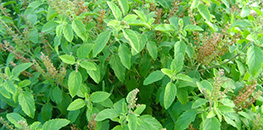Crop Cultivation Guidence
Ocimum (Tulsi)
Introduction:
The genus Ocimum (tulsi) belongs to the family Labiateae. Many species of Ocimum contain various economically important essential oils used in perfumery and cosmetics industries. The major constituents in Ocimum oils include linalool, geraniol, citral, camphor, eugenol, methyl chavicol, safrol, thymol, methylcinnamate etc. Ocimum species are used as herbs and find diverse uses in the indigenous systems of medicine in countries like India, Africa, Arabia, Australia, Malaya, pacific islands and Sri Lanka. The oil of certain species of Ocimum has the antifungal, bactericidal and insecticidal properties too.
Verieties
The Regional Research Laboratory, Jammu has done extensive crop improvement programme in ocimum and evolved newer promising types,
which are now recommended for commercial cultivation. The varieties are:
O. canum RRL-01,
O. americanum RRL-02
O. viride RRL-08
O. gratissimum RRL-08
O. basilicum RRL-07
O. basilicum RRL-011
Synthesized Amphidiploid of Ocimum RRL-015
O. gratissimum
Climate and Soil:
It is a tropical to subtropical plant, it prefers fairly to high rainfall areas with high humid conditions. Long day and high temperature condition enhance growth and higher oil production.Ocimum can be grown in rich loam to poor lateritic soils. It can also come up in saline or alkaline soils to moderately acidic soils. Proper drainage is however essential as waterlogging condition results in poor growth.
Field Preparation:
The land is well prepared with two or three ploughings until a fine a fine tilth of soil is obtained. Farmyard manure may be applied before the 2nd or 3rd ploughing. The crop is raised from seeds and can be grown annually from the middle of February to the end of September by direct sowing or transplanting.Manures – Generally, no manure is required, but an application of 20-25 Kg of NOTES and 10-15 Kg of P per hectare after one month from planting give good herbage and oil yield. Micronutrients given as foliar spraying especially 50 ppm of Cu and 100 ppm of Mo increase the total oil content in O. sanctum





